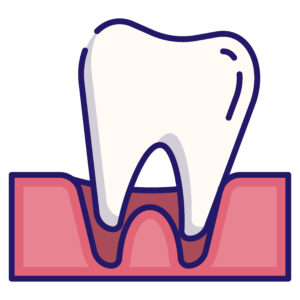Why is My Tooth Loose?
 Unless you are between the ages of six and thirteen years old, a loose tooth is a serious problem. Regardless of the cause, the first thing you need to do is see your dentist as soon as possible. In this article, we will discuss the various causes of loose teeth, the necessary treatment, and the long-term consequences.
Unless you are between the ages of six and thirteen years old, a loose tooth is a serious problem. Regardless of the cause, the first thing you need to do is see your dentist as soon as possible. In this article, we will discuss the various causes of loose teeth, the necessary treatment, and the long-term consequences.
What Causes a Loose Tooth?
We can divide the causes of loose permanent teeth into two categories. Some are the result of injuries, and others occur due to the damaging effects of dental disease.
-
Injuries that Loosen a Tooth or Teeth
 Any time someone suffers an injury to the face or mouth, loose teeth can result. This type of injury can also cause chipped teeth, broken tooth roots, or fractures of the jawbone. If the injury does not break the tooth or bone, it is likely to loosen the tooth.
Any time someone suffers an injury to the face or mouth, loose teeth can result. This type of injury can also cause chipped teeth, broken tooth roots, or fractures of the jawbone. If the injury does not break the tooth or bone, it is likely to loosen the tooth.
Every tooth is connected to the surrounding jawbone via a ligament called the periodontal ligament. This ligament, like any other in the body can be stretched or town in response to heavy force. In addition to stretching or tearing this ligament, an injury to the mouth can actually change the shape of the bone. Especially on the upper teeth, the jawbone is relatively soft and compressible. An injury that puts pressure on a tooth can widen the socket of bone encasing it.
-
Dental Disease that Loosens a Tooth or Teeth
In cases of dental disease, it is not widening or stretching of the tissues surrounding tooth that leads to loosening. It is destruction of those tissues. This can occur from advanced gum disease or severe dental infections.
Gum disease begins with the bacteria living in dental plaque. These bacteria collect around a tooth or teeth and produce toxins. The toxins penetrate the gum tissue and cause an inflammatory response by the body. When left untreated, the inflammation slowly destroys the surrounding ligament, jawbone and gum tissues of the diseased area. As the tooth loses its attachment to the surrounding hard tissue, it can begin to loosen. A good analogy in nature is a plant that has erosion of the ground surrounding it. Eventually, there will be little holding the plant in place, and it will tip or fall over. In the mouth, the tooth becomes loose before it falls out completely.
In the case of a dental infection from an abscessed tooth, the bacterial toxins produce a similar response around the end of the tooth’s root. As bone steadily erodes away, the tooth can actually loosen from the “bottom” up. This is less common than gum disease. It may cause a tooth to appear “longer” than the neighboring teeth as the infection presses on the end of the root. Typically, you can press vertically on the tooth to push it back into place.
How Does the Dentist Treat a Loose Tooth?
The treatment always depends on a clear diagnosis of the problem. Your dentist will use dental imaging, either close-up x-rays or three-dimensional imaging, to evaluate the health of the tooth itself and all of its surrounding tissues. This is necessary to rule out any root or jawbone fractures. It is also an essential part of properly diagnosing dental disease.
In cases of injury, stabilization is necessary to allow the body to heal the tissues around a tooth. This may include wearing a mouthpiece or having a piece of wire bonded across multiple teeth to hold them in place. It always includes removing any unnecessary pressure from the affected teeth, so you will need to follow your dentist’s instructions as strictly as possible. We know no one wants to stick to a liquid diet, but we also know it will give you the best chance at complete healing!
When the cause of looseness is gum disease, your dentist must determine the long-term prognosis of periodontal treatment. In some cases, the bone loss is too extensive to save the tooth. When periodontal treatment has a poor or hopeless prognosis, your dentist will extract the loose tooth or teeth. In cases where intervention with gum treatments will lead to successful reattachment of the tissues around the affected teeth, you may be able to save them.
When a dental abscess from a large cavity or crack causes the looseness, the surrounding tissues will usually heal quite well around the tooth once the dental treatment completely removes the source of the infection. This usually involves a root canal treatment to remove the infected tissue from the inside of the tooth. Once we’ve stopped the bacterial toxins, the bone and ligament around the tooth will heal and reattach.
What are the Long-Term Consequences of a Loose Tooth?
Even after a loose tooth undergoes treatment and heals, it could stay at risk for other consequences in the future. When a blunt force injures a tooth and its surrounding tissues, the nerve within is at risk for dying. Some people whose teeth have re-stabilized will require root canal treatments on the injured teeth years after the injury.
Those whose loosened teeth were treated for dental disease remain at risk for a return of those infections. Patients with gum disease must keep an attitude of lifelong maintenance to prevent it from returning and causing more destruction. Teeth that have root canals can become re-infected, requiring additional treatment.
The important thing to understand is that any loose tooth or teeth require long-term follow-up care by your dentist. When you see your dentist on a consistent basis, she will monitor the teeth closely for signs of recurring problems. Regardless of the cause of the looseness, you must remain vigilant for future problems. Early intervention gives the highest chance for success!
More Questions about Loose Teeth?
Call Designer Smiles today to schedule a consultation with Dr. Ann. She can answer your specific questions, properly diagnose your problem, and discuss your treatment options.
